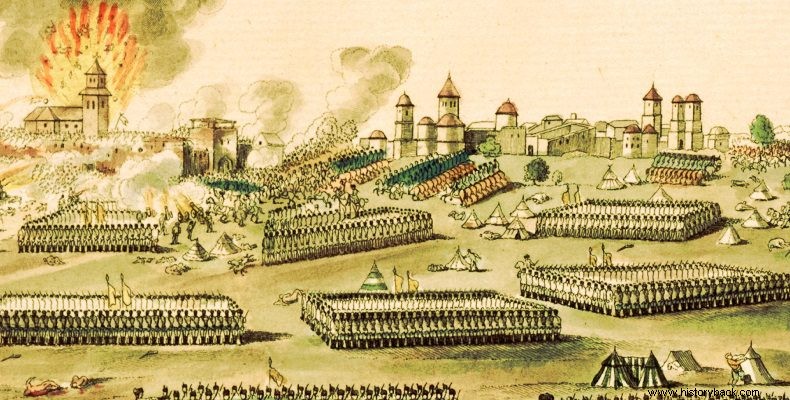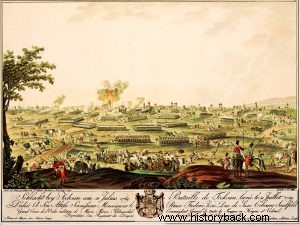
The Battle of Foksani is one of the most important of the Austrian and Russian war against the Turks. The war began as a Russo-Turkish war in 1787, but the following year the Habsburg Empire joined Russia on the side.
In the mid-summer of 1789 a small Austrian army under the worthy general Prince Josiah of Saxe-Coburg , with a strength of only 18,000 men, had been sent to the area of present-day Romania with a mainly defensive mission. A small Russian force of 7,000 men, under General Suvorov, hastened to join this force. . Against them the Turks gathered imposing forces under the grand vizier Yusuf Pasha .
The Turkish commander decided, maneuvering on internal lines , to strike against the Austrians before they joined their Russian allies. For this purpose he ordered Osman Pasha , to whom he assigned 30,000 men, to move north from Phoksani. The city was an important economic and mainly transportation hub for the time. Saxe-Coburg, however, was informed of the Turks' movements and sent a message to Suvorov to hurry to meet him as quickly as possible. Indeed the Russians covered a distance of 65 km in 28 hours, meeting their allies.
To the battle
After the union of the two allied forces Yusuf's plan collapsed and Osman Pasha organized himself defensively by establishing a fortified camp near the city. On 31 July Allied light cavalry reconnaissance patrols clashed with Turkish patrols. However, the two allied commanders got an idea of the Turkish arrangement and decided to attack. Suvorov had under his command three regiments of line infantry and one battalion of light infantry (each with two battalions), two battalions of grenadiers, three regiments of dragoons and a detachment of Cossack light cavalry.
Saxe-Coburg had four line infantry regiments, two Grenz light infantry regiments, four elite grenadier battalions , a regiment of light dragoons (Chevauxleger), three regiments of hussars and a detachment of Balkan irregulars. From their previous conflicts with the Turks both Suvorov and Saxe-Coburg had concluded that linear tactics could not be applied.
Only deeper formations could withstand the onrushing, initial Turkish attack. Thus they formed their infantry into "masses" , a deep formation, something between a closed square and a dense assault phalanx. These formations allowed fire to be carried out, they could easily form a perimeter "forest of sabers" cutting off the Turkish cavalry's appetite to advance, while at the same time they could move quickly without losing their cohesion.
Mass feed…
Thus on the morning of August 1, 1789 the allied army was deployed with the infantry in massed formation, with ample gaps between the masses covered by the light infantry and artillery. Behind the gaps of the masses of the first line were the masses of the second line so that in case of need they could, immediately, move forward forming a single front, or in case of accident, support the infantry of the first line if this retreated, without losing their cohesion.
At 09.00 in the morning with the flags flying and the drums giving the rhythm, the allied army advanced against the fortified Turks. Osman Pasha did not wait idly for the attack but ordered his cavalry to attack and crush the opposing infantry. But then the masses spoke... The Austrian and Russian infantry, unwavering, opened deadly fire against the opponents in absolute safety. In reality the regular infantry was only in danger from the enemy's cavalry if they were attacked in flank or rear, or if they lost their cohesion through panic or casualties.
In this case the formation of the masses had this very advantage. He presented no flanks or backs to the opponent and because of his depth he was unlikely to lose his composure. Suffering significant losses, the Turkish horsemen retreated inside their fortified camp. But the allies did not stop. The Austrians attacked on the right and the Russians on the left. Suvorov sent his cavalry in the first echelon but was repulsed. It took the intervention of the masses of infantry to decide the fight.
On the right, the Austrians, led by elite grenadiers, after a fierce battle with bayonets, stocks and swords, overran the Turkish fortifications, invading the Turkish camp. Turning his reserves to face the Austrians, Osman weakened his right flank and as a result the Russians also managed to break through the fortified Turkish line.
With his two wings in the 'air' Osman had no choice but to order a general retreat. The Turkish superiority in cavalry allowed the retreat to be carried out in an orderly manner without being pursued by the Christian cavalry. The Turks suffered 4,000 casualties against only 800 Austrian and Russian dead and wounded. The allies also captured 12 Turkish cannons. However, worse will soon follow for the Turks.

